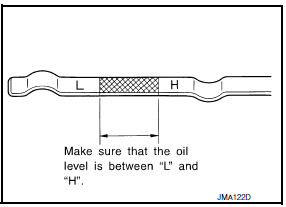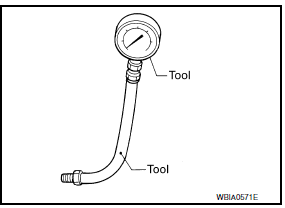Nissan Maxima Service and Repair Manual: Engine oil
Inspection
OIL LEVEL
NOTE:
- Before starting the engine, check the oil level. If the engine is already started, stop it and allow 10 minutes before checking.
- Check that the oil level is within the range as indicated on the dipstick.
- If it is out of range, add oil as necessary until the dipstick indicates the correct level.

ENGINE OIL APPEARANCE
- Check engine oil for white milky appearance or excessive contamination.
- If engine oil becomes milky, it is highly probable that it is contaminated with engine coolant. Repair or replace damaged parts.
OIL LEAKAGE
Check for oil leakage around the following areas:
- Oil pan
- Oil pan drain plug
- Oil pressure switch
- Oil filter
- Oil cooler
- IVT cover
- Front cover
- Mating surface between cylinder block and cylinder head
- Mating surface between cylinder head and rocker cover
- Crank oil seal (front and rear)
OIL PRESSURE CHECK
WARNING:
- Be careful not to burn yourself, as engine oil may be hot.
- Put the CVT shift selector in the Park "P" position.
- . Check the oil level. Refer to OIL LEVEL.
- Remove engine under cover. Refer to EXT-15, "Exploded View".
- Disconnect oil pressure switch harness connector at the oil pressure switch. Remove oil pressure switch using suitable tool and install Tools.
CAUTION: Do not drop or shock oil pressure switch.

Tool numbers : ST25051001 (J-25695-1)
: ST25052000 (J-25695-2)
- Start the engine and warm it up to normal operating temperature.
- Check oil pressure with engine running under no-load, using Tool.
If difference is extreme, check oil passage and oil pump for oil leaks.
- After the inspections, install the oil pressure switch using suitable tool as follows:
- Remove the old sealant adhering to oil pressure switch and engine.
- Apply thread sealant and tighten the oil
pressure switch to specification.
Use Genuine High Performance Thread Sealant, or equivalent.
- After warming up engine, make sure there are no engine oil leaks.
- Install engine under cover.
Changing Engine Oil
WARNING:
- Be careful not to burn yourself, as the engine oil may be hot.
- Prolonged and repeated contact with used engine oil may cause skin cancer; try to avoid direct skin contact with used oil. If skin contact is made, wash thoroughly with soap or hand cleaner as soon as possible.
- Position the vehicle so it is level on the hoist.
- Warm up the engine and check for oil leaks from the engine.
- Stop engine and wait for 10 minutes.
- Remove the oil pan drain plug and oil filler cap.
- Drain the engine oil.
- Install the oil pan drain plug with a new washer and refill the engine with new engine oil.
CAUTION:
- Be sure to clean the oil pan drain plug and install with a new washer.
- The refill capacity depends on the oil temperature and drain time. Use the specifications for reference only. Always use the dipstick to determine when the proper amount of oil is in the engine.
- Warm up the engine and check around the oil pan drain plug and oil filter for oil leaks.
- Stop engine and wait for 10 minutes.
- Check the engine oil level using the dipstick.
CAUTION: Do not overfill the engine with engine oil.
 Oil filter
Oil filter
Removal and Installation
REMOVAL
Drain engine oil. Refer to LU-9, "Changing Engine Oil".
Remove front fender protector side cover (RH). Refer to EXT-15,
"Exploded View".
...
Other materials:
Trunk lid
TRUNK LID ASSEMBLY
TRUNK LID ASSEMBLY : Removal and Installation
CAUTION:
Use two people when removing or installing trunk lid assembly
due to its heavy weight.
Use protective tape or shop cloths to protect surrounding
components from damage during removal
and installation of tr ...
Magnet clutch
Description
SYSTEM DESCRIPTION
A/C auto amp. controls A/C compressor operation by ambient temperature and
signal from ECM.
Low Temperature Protection Control
A/C auto amp. will turn the A/C compressor ON or OFF as determined
by a signal detected by ambient sensor.
When ambient temper ...
Both side headlamps (LO) are not turned on
Description
The headlamps (both sides) do not turn ON in any lighting switch setting.
Diagnosis Procedure
1.CHECK COMBINATION SWITCH (LIGHTING AND TURN SIGNAL SWITCH)
Check the combination switch (lighting and turn signal switch
2.CHECK HEADLAMP (LO) REQUEST SIGNAL INPUT
CONSULT DATA MONITOR
...
Nissan Maxima Owners Manual
- Illustrated table of contents
- Safety-Seats, seat belts and supplemental restraint system
- Instruments and controls
- Pre-driving checks and adjustments
- Monitor, climate, audio, phone and voice recognition systems
- Starting and driving
- In case of emergency
- Appearance and care
- Do-it-yourself
- Maintenance and schedules
- Technical and consumer information
Nissan Maxima Service and Repair Manual
0.0079

